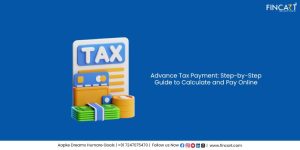Table of Contents
ToggleYou may have noticed when you receive your salary, a certain percentage is missing from it. This missing portion of your salary is known as Tax Deducted at Source or TDS, and as the name implies it is the tax that is deducted before you even get your hands on your money. When you are young and just starting your career, this concept can seem especially confusing, but worry not! After reading this article, you’ll understand all you need to know about TDS. You’ll understand what TDS is, how it works, look at some common types of TDS, how TDS is paid online, and how you can claim a refund of TDS online.
TDS Full Form and TDS Definition
Let’s start with the meaning of TDS, TDS full form is tax deducted at source, and it is a type of tax that is deducted in advance at the source of your income. One can have many sources of income. If you earn income from certain sources, such as salary, interest, rent, or professional fees, a portion of that income is taken or deducted by the payer or deductor, and submitted directly to the government as tax on your behalf, the deductee. Meaning if you are a salaried employee, your employer will deduct the TDS before you receive your monthly salary.
If you have a fixed deposit, your bank will deduct a percentage of your interest before you receive it, and so on. Some types of income where TDS is applicable are salary, interest, rent, professional fees, brokerage, commission, contract payment, winnings from the lottery, online games, royalties, and many more.
Let’s take an example to understand TDS better. Mr. Ali is an artist who works on a commission basis. He charges Rs. 10,000 per painting. Mr Ali’s income in this case can be classified as professional fees. Now a school regularly purchases Mr Ali’s paintings. The school has to deduct a certain percentage of Mr Ali’s fees before they pay him. In this case, the TDS rate is 10%, so Mr Ali will receive only Rs. 9,000 per painting and the school will deposit Rs. 1,000 with the Income Tax Department on Mr Ali’s behalf.
How Tax Deducted at Source (TDS) Works?
For more efficient tax management you must consult a tax planner who can efficiently utilize TDS (Tax Deducted at Source) to optimize tax management. Simply, the responsibility to deduct tax falls on the shoulders of the person or organisation that is making a payment. They must correctly assess the TDS rate associated and cut that amount before they pay the deductee. The deductor’s next important task is to deposit the cut amount with the government. If the deductor fails to do so, or charges a different TDS rate than the law states, they can be penalised harshly.
Components of TDS
According to the Income Tax Act, there are different types of payments where taxes are eligible to be deducted. Some examples of such payments are – salary, interest, professional fees, rent, winnings such as lottery and races, royalties, contractor fees, commission, and more. Most commonly TDS is deducted from salary, interest, professional fees, and rent. Let’s take a look at these four in detail:
A. TDS on Salary
TDS on salary is one of the most common types of TDS deducted. One can find the rules for TDS on salary in Section 192 of the Income Tax Act. This tax is deducted by the employers, and they are responsible to deposit tds online. The rate of TDS is determined by the tax slab of the employee. People earning below Rs. 2,50,000 per year are exempt from this tax. If the employee is a senior citizen, the exemption limit rises to Rs. 3,00,000, and Rs. 5,00,000 for very senior citizens. According to your tax slab, you can calculate tds on salary.
B. TDS on Interest
This type of TDS is deducted when you earn interest from fixed deposits, recurring deposits, or other such investments. Section 194A of the Income Tax Act deals with the TDS on interest other than interest on securities. The TDS rate is 10%, and up to Rs. 10,000 interest earned per year is exempt if it is received from a bank, cooperative bank, or post office. If interest payment is made by other cases, the exemption limit decreases to Rs. 5,000.
On the other hand, Section 193 deals with TDS on interest on securities. The TDS rate in this case is 10%, while interest up to Rs. 5,000 per year is exempt from any TDS in case of debentures.
C. TDS on Rent
Section 194I deals with TDS on rent. This includes rent on buildings, land, industrial plants, and equipment like computers, machinery, fittings, furniture, etc. This type of tax is deducted by the person renting the property and is liable to pay the TDS to the government. When renting land, buildings, furniture, or fittings, the TDS rate is 10%, while only 2% is deducted when rent for plant, machinery, or equipment is concerned. If the total tax paid by individuals is over Rs. 50,000 per month, a TDS rate of 5% is applicable under Section 194IB.
D. TDS on Professional Fees
Professional or technical fees include payments made when using the services of professionals such as freelancers, lawyers, accountants, and architects, among many others. According to Section 194J, if you make a payment to any such professional you are required to deduct a TDS. The TDS rate for a resident professional is 10%, and 2% for payments made to a business running only a call center. Up to Rs. 30,000 in a fiscal year is exempt from TDS on professional fees.
If the professional does not provide a PAN, the rate of TDS increases to 20%.
Read More: Key Advantages of Tax Planning in 2024
Don’t fall behind your taxes!
Get in touch with Fincart to handle your taxes and optimize your savings.
TDS Filing and Compliance
A. TDS Return Filing
1. Frequency of filing
TDS returns filing is done on a quarterly basis. These quarters are – April to June, July to September, October to December, and January to March.
2. Due dates
The due dates for filing TDS are:
- For quarter ending on 30th June – 31st July
- For quarter ending on 30th September – 31st October
- For quarter ending on 31st December – 31st January
- For quarter ending on 31st March – 31st May
When TDS is deducted monthly, it must be deposited with the authorities on or before the 7th of the next month. An exception is TDS deducted in March when the last day to deposit TDS is the 30th of April.
B. TDS Certificates
1. Form 16 for salary TDS
Form 16 is issued under Section 203. This form is used to calculate the amount of tax owed and is only applicable to a salary income. In the case of salary, the employers are responsible for deducting tax at submitting it to the government. You can think of Form 16 as a certificate that acknowledges the employer has deducted your tax and deposited it with the authorities.
2. Form 16A for non-salary TDS
Form 16A on the other hand is used for TDS on income other than salary, such as income from fixed deposit interest. It contains the name, address, PAN, and TAN details of the deductor and the deductee, as well as the challan information of the TDS.
Penalties for non-deduction or late deposit of TDS
There are different penalties associated with non-deduction or late deposit of TDS
1. Penalties for non-deduction:
If the deductor fails to deduct TDS, or deducts it at a lower TDS rate than the law states, then the deductor has to pay a penalty equal to the amount of tax that should have been deducted. On top of this, the deductor also has to pay 1% interest on that amount per month he failed to deduct TDS. It’s easier to understand with an example – Mr Maini has to pay rent of Rs. 60,000 each month. As a tenant, it’s his responsibility to deduct tax of Rs. 3,000, which is 5%. If Mr Maini fails to deduct TDS from his rent for one month, he will have to pay Rs. 3,000 plus 1% interest.
Section 201(1A) deals with the interest penalties and also states that if the TDS was deducted and not deposited with the IT Department on time, the interest rate increases to 1.5%.
2. Penalties Late Filing of TDS:
Penalties for late filing are stated under Section 243E of the Income Tax Act. If the deductor fails to file TDS returns within the due date, he or she has to pay a penalty of Rs. 200 per day until the return is filed. But this daily penalty will stack only till it reaches the original amount of the TDS that was deducted. This means that if you had to pay a TDS of Rs. 4,000 and you missed the deadline and filed after say 100 days, you won’t have to pay 200 x 100 = Rs. 20,000. Since that exceeds the original TDS amount, one has to pay Rs. 4,000. The interest penalty of 1% per month also applies to penalties associated with late filing of TDS.
TDS Refund
A. Process of claiming TDS refund
If you pay more TDS to the government than you owe, you can claim a refund by filing an income tax return. Here is how you can start the process of claiming the refund online:
- Go to the official income tax portal.
- Log in or register using your PAN, Aadhar, or User ID.
- Now you need to file your income tax returns using the relevant ITR form.
- Submit all the basic information required as well as the correct details of your bank account to ensure a smooth refund process.
- In the end, you have to e-verify your ITR. This is an important step that must be completed within 30 days of filing ITR. This can be done through Aadhar OTP or via EVC from your bank’s ATM.
After the Income Tax Department processes your claim successfully, you will receive the excess TDS amount in your bank account.
B. Reasons for TDS refund
Here are three reasons for claiming a TDS refund:
- When your employer deducts more TDS than applicable. Use Form ITR 3 to claim a TDS refund in this case.
- When a bank deducts TDS from the interest of your fixed deposit when your income does not fall into the income tax bracket. You can use Form 15G in this case.
- For senior citizens, fixed deposit interest up to Rs. 50,000 per year is exempt from tax, so if they do not have any taxable income, they can use Form 15H to claim the TDS refund.
Also Read: Tips to Save Income Tax on Salary
What are the rules for Tax Deducted at Source?
The rules for TDS are listed in the various sections of the Income Tax Act of 1961. These rules are regularly updated. For example, in 2023 TDS on winnings from online gaming came into effect under Section 194 BA.
FAQs on TDS
What is the full form of TDS?
TDS stands for Tax Deducted at Source. Through this process, the Income Tax Department collects tax in advance at the source of income.
What is the current TDS rate?
The TDS rate depends on the type of income. Rental income will have a different TDS rate compared to TDS on salary.
What is the TDS on salary?
TDS on salary depends on the income tax slab rate of the employee.
What is the TDS rate for a 50000 salary?
The TDS rate for a Rs. 50,000 salary depends on different factors such as allowances (Home Rent Allowance, Leave Travel Allowance), deductions, and exemptions that are availed by the employee.
Who is eligible for a TDS deduction?
Any person or organisation that makes specified payments as per the provisions of the Income Tax Act, such as salary, rent, using services of a professional, etc. is required to deduct TDS. For example, an employer must deduct TDS from an employee’s salary if it exceeds the basic exemption limit.
What is the penalty if an employer fails to submit the returns within the due date?
Under Section 234 E, failure to submit TDS returns within the due date means the employer will have to pay Rs. 200 per day for each day the employer delays the submission. Moreover, an interest of 1% or 1.5% has to be paid on the TDS amount each month.
Is PAN required for payment of TDS?
Yes, PAN is necessary. For example, if you are a professional a 10% TDS from your fee is deducted. Without a PAN, 20% will be deducted
What is the use of the TDS challan?
When you file your TDS return, a TDS challan is generated. This TDS challan is used for depositing TDS with the government under the correct classification code.




